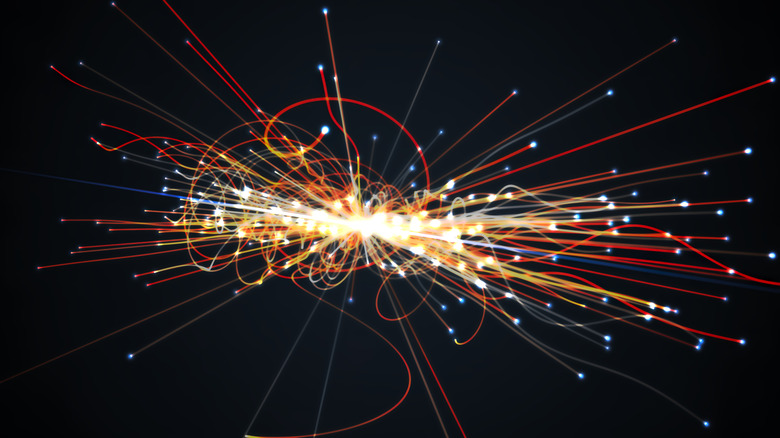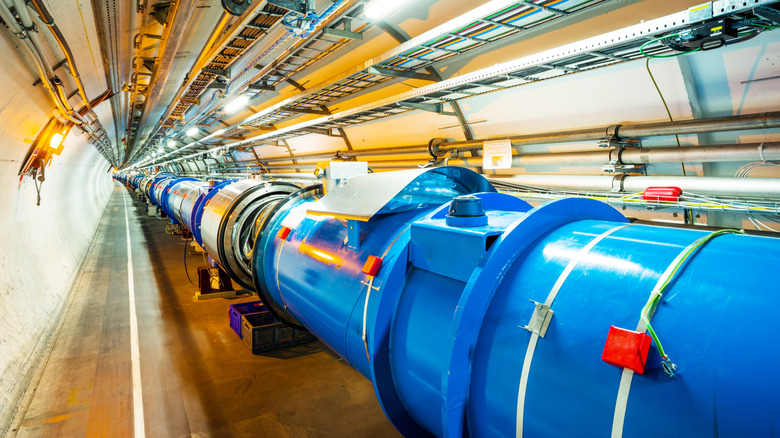The Most Expensive Substance In The Universe Seemed Almost Impossible To Make
If you asked a random person to name the most expensive substance in existence, you'd probably hear a lot of guesses centered on precious material deposits like gold, platinum, or oil. All fetch a pretty penny, to be sure, but they are worth mere peanuts compared to antimatter, a substance so expensive to produce that we struggle to even quantify its cost.
Antimatter, not to be confused with the mysterious dark matter, the substance thought to possibly exist before the Big Bang, is extremely rare in the known universe. It is produced in cosmic rays, charged particles that are zipping all across the universe. However, Earth's atmosphere and magnetic fields destroy most cosmic rays before they even reach the planet. In order to study real antimatter, scientists are working to produce it in particle accelerators, but antiparticles vanish almost as soon as they are made.
It is impossible to accurately put a price tag on antimatter when we have never managed to make more than a few antiparticles at a time. Projected costs range wildly, but all signs point to a ludicrous expense. An oft-cited NASA study estimated that producing a single gram of antiprotons would cost $62.5 trillion. Some say it would be even more than that. In an interview with ABC News Australia, physicist Michael Doser, who researches antimatter at CERN, declared that 1/100 of a nanogram of antimatter would the same as a kilogram of gold, making a gram of antimatter worth around $5.8 quadrillion. That's thousands of times more than all of the money on Earth.
What is antimatter?
Antimatter is a substance composed of antiparticles, which begs the obvious question, what on Earth is an antiparticle? Antiparticles are just like regular particles, but with opposite electromagnetic properties. Instead of negatively charged electrons, they have positively charged positrons; instead of positively charged protons, they have negatively charged antiprotons; and instead of neutrons, they have antineutrons, which both have neutral charge, but different magnetic moments. For every type of particle in the universe, there is also an antiparticle, and even though they have opposite charges and magnetic moments, they both share the exact same mass and spin.
All of the matter that has, does, and ever will exist originated with the Big Bang, and the same is true for antimatter. However, for reasons currently unknown by scientists, the birth of the universe produced slightly more matter than antimatter. If that hadn't been the case, matter and antimatter would cancel each other out, and nothing would exist. Whenever matter and antimatter come within close range of each other, they annihilate each other in a burst of gamma ray energy.
The fact that antimatter cannot exist near matter for more than a fraction of a second makes every particle a precious commodity. Scientists believe that the immense energy produced by matter-antimatter reactions could be the key to powering spacecraft far enough to reach other solar systems. However, with our current technologies, we are far from ever producing enough of the stuff.
How to make antimatter
The first time that humans successfully manufactured antiprotons was in 1955, using a particle accelerator called the Bevatron, the most powerful of its time, located at Lawrence Berkeley National Laboratory in California. In 1995, the a team at CERN (European Organization for Nuclear Research) managed to create an atom of antihydrogen, the first time actual antimatter was created by human technology. However, making antimatter in a particle accelerator, such as CERN's Large Hadron Collider, presents a big problem. The antihydrogen they managed to create was annihilated in just a few millionths of a second, too quickly for it to be captured and stored for any long-term research purposes. That's the root of antimatter's ridiculous price tag: The yield obtained for each dollar is minuscule and fleeting.
The antiprotons created by particle accelerators have so much energy that they are almost impossible to study, but CERN has a new approach to the issue. The Antiproton Decelerator (AD) is a machine that takes antiparticles produced by a particle accelerator and slows them down by trapping them in a powerful electric field. Using this technology, researchers have been able to create antimatter atoms and contain them for as long as 16 minutes, allowing for the first detailed studies of antimatter's properties, and potentially opening new doors for its production in the future, hopefully at a cost lower than the entire global economy.


